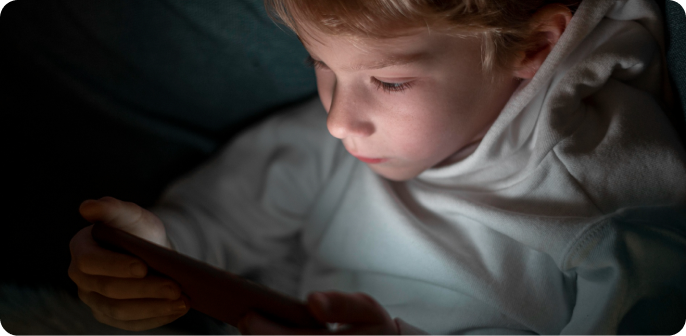Many families have specific rules about screens in relation to bedtime or the bedroom.
Common examples include:
- No phones in the bedroom
- Phones are charged downstairs overnight
- No screens for 1 hour before bedtime
- Phone must be in “do not disturb” mode or similar overnight
- Phone is locked down with Kidslox overnight
Phone is locked down with Kidslox overnight
All of these are good, practical ideas, rooted in the understanding that phones have a lot of potential to disrupt our children’s sleep (both quantity and quality). Let’s explore further.
First off, it’s worth recognising that children are often not able to control their impulses in the same way adults are, and are thus particularly susceptible to addictive behaviours. When the night time is seen as a period when they have free reign to access their phone, unsupervised, without limits or controls, many children end up staying up late playing games, chatting with people online, or watching videos.
This leads to tiredness, the effects of which I’m sure you’re familiar with! We all need to get a good nights sleep to function properly, and for children this is especially true. This is a key reason why so many families choose to block access to phones at night via Kidslox.
Sometimes, even if a child is able to resist the temptation to stay up late using their phone, they still struggle to resist checking notifications as they come in, in some cases waking up multiple times in the night to do so.
It’s also worth noting that the unsupervised privacy of a bedroom is seen by some kids as a good opportunity to explore content (from games, to sites, to videos, and more) that they wouldn’t usually be allowed to engage with. This tendency leads many families to place desktop computers in communal spaces, and keep TVs out of bedrooms too, not just phones. This leaves open the possibility that you’ll sometimes look over their shoulder and see what they’re engaging with.

However, there’s another side to this discussion, even if we’re confident that our children’s behaviour is not concerning. The blue light emitted by screens can disrupt the body’s natural sleep-wake cycle, making it difficult for children (and adults too) to fall asleep and stay asleep. Excessive screen time before bedtime has been linked to poor sleep quality and daytime drowsiness, impacting overall health and well-being.
The practical way to combat this effect is to make sure you avoid screens for at least 1 hour, preferably even 2 hours before going to sleep. You can also decrease this effect by absorbing plenty of natural blue light during the day to reduce sensitivity to the light emitted by screens – this means spending time outdoors during the daylight hours.
A few other practical ways to reduce the impact of screens on sleep include:
- Get your child a traditional alarm clock so they can’t use “my phone is my alarm” as an excuse to keep their phone next to their pillow
- Encourage physical exercise and outdoor play during the day for better sleep
- Help your child develop a consistent bedtime routine which includes turning their phone off or placing it on a charger outside of their room at least an hour before they will sleep
- Set up a charging area, where everybody charges their phones, not just children
- Consider if there are other ways your example is teaching your child to keep their phone with them at night
As with all household rules, it’s likely that needs will change as your children grow, don’t be afraid to re-assess what’s working and what’s not, and try out a new approach if you feel older rules have stopped being effective for you.
